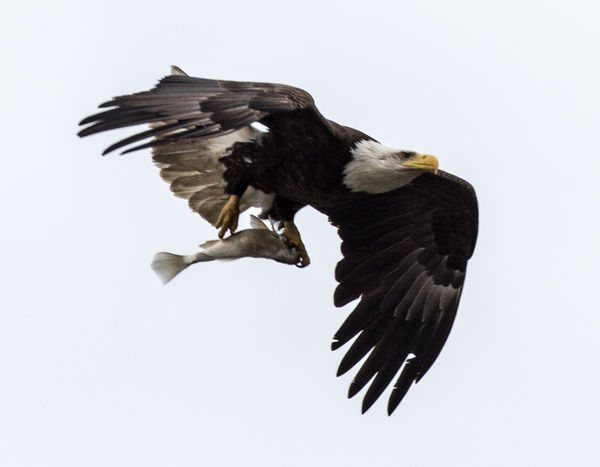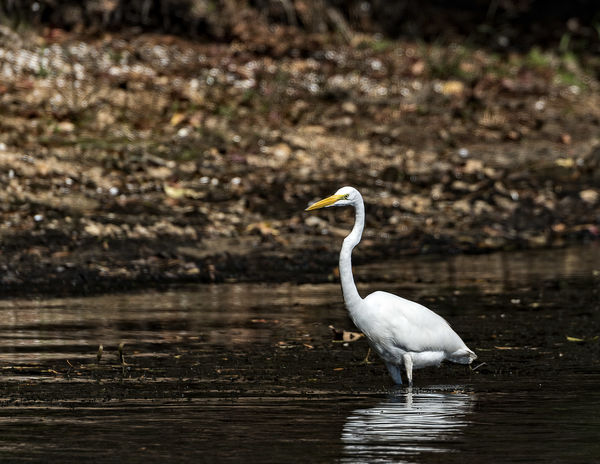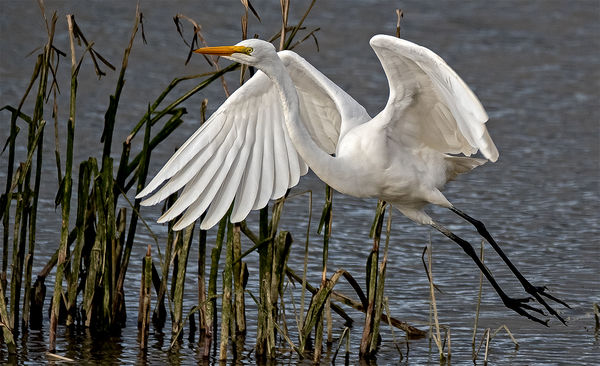How would you have shot this?
Oct 11, 2018 18:01:08 #
OK folks, I'm confused (actually, it doesn't take much!  ). I'm basically asking the same question asked earlier by juan_uy.
). I'm basically asking the same question asked earlier by juan_uy.
Bracketing is used to get images at exposures above and below those selected by the meter so that you can pick the one you like best. HDR processing, used for High Dynamic Range scenes, combines two or more exposures based on highlights and shadows to produce an image with the proper tonal range.
So, with regard to bracketing, I have trouble understanding how you can bracket an exposure when you have a moving subject. Don't you get ghosting? How do you handle that?
WRT to HDR, is there really an issue with High Dynamic Range in the OP's image? Isn't the issue exposure of the bird? Is the background exposure important enough to warrant HDR?
 ). I'm basically asking the same question asked earlier by juan_uy.
). I'm basically asking the same question asked earlier by juan_uy.Bracketing is used to get images at exposures above and below those selected by the meter so that you can pick the one you like best. HDR processing, used for High Dynamic Range scenes, combines two or more exposures based on highlights and shadows to produce an image with the proper tonal range.
So, with regard to bracketing, I have trouble understanding how you can bracket an exposure when you have a moving subject. Don't you get ghosting? How do you handle that?
WRT to HDR, is there really an issue with High Dynamic Range in the OP's image? Isn't the issue exposure of the bird? Is the background exposure important enough to warrant HDR?
Oct 11, 2018 18:40:32 #
srt101fan wrote:
...with regard to bracketing, I have trouble understanding how you can bracket an exposure when you have a moving subject. Don't you get ghosting? How do you handle that?
WRT to HDR, is there really an issue with High Dynamic Range in the OP's image? Isn't the issue exposure of the bird? Is the background exposure important enough to warrant HDR?
WRT to HDR, is there really an issue with High Dynamic Range in the OP's image? Isn't the issue exposure of the bird? Is the background exposure important enough to warrant HDR?
Here's Richard Taylor's examples of HDR with moving subjects:
https://www.uglyhedgehog.com/t-558299-1.html
I guess success depends on how fast they're moving

I agree with you that HDR probably shouldn't have been mentioned, either as part of the "bracketing" suggestion or as true HDR, and for the reason you suggest.
But you know how these conversations can wander: an innocent comment can lead to a side bar. Or a term that's correct for one camera or process may not be for another, so it becomes confusing.
Oct 11, 2018 20:47:00 #
Linda From Maine wrote:
Here's Richard Taylor's examples of HDR with movin... (show quote)
Thanks Linda, appreciate your on-target comments.
Still trying to figure out how all this relates to the OP's questions....
Oct 11, 2018 20:58:01 #
srt101fan wrote:
Thanks Linda, appreciate your on-target comments.
Still trying to figure out how all this relates to the OP's questions....
Still trying to figure out how all this relates to the OP's questions....
The original bird was over exposed. The suggestion to try bracketing as a means of getting the correct exposure (I never do that - I only bracket when I think the dynamic range in the scene is more than the camera can handle (HDR)).
If you do bracket then hopefully one of the images will have the correct exposure even though the images will be slightly different for moving subjects, which may not matter as you are not going to merge them.
Oct 11, 2018 22:04:12 #
RichardTaylor wrote:
The original bird was over exposed. The suggestion to try bracketing as a means of getting the correct exposure (I never do that - I only bracket when I think the dynamic range in the scene is more than the camera can handle (HDR)).
If you do bracket then hopefully one of the images will have the correct exposure even though the images will be slightly different for moving subjects, which may not matter as you are not going to merge them.
If you do bracket then hopefully one of the images will have the correct exposure even though the images will be slightly different for moving subjects, which may not matter as you are not going to merge them.
Thanks Richard. I guess it makes sense, especially, as you said in an earlier post, if the subject motion isn't excessive.
Oct 12, 2018 02:37:42 #
I probably would have set to a fixed ISO based on light conditions, and then put the camera into shutter priority mode. When you need to react really fast, manual exposure setting is usually not ideal, as you have to fiddle with multiple parameters before you can release the shutter.
Oct 12, 2018 06:18:20 #
Since the egret is white it is very difficult to get detail in the feathers in the first place, you notice in my shot where I had ample time to make adjustments, this is the best I could do to get detail in the shot.
swartfort wrote:
Please don't start off by telling me I don't under... (show quote)
Oct 12, 2018 07:51:00 #
billnikon
Loc: Pennsylvania/Ohio/Florida/Maui/Oregon/Vermont
swartfort wrote:
Please don't start off by telling me I don't under... (show quote)
1. Center weighted metering. 2. exposure compensation -.7 3. need to be either closer to bird or Full Frame or longer lens.
Keep working on it, you are almost there.
Oct 12, 2018 08:20:42 #
You did well to get what you did. My biggest recommendation would be stick with your original plan. In my opinion, your misstep was your farting around with the "fauna", which I think should have been flora, if I'm not mistaken. In paying attention to other than your intended subject you undermined your initial plan of photographing birds.
--Bob
--Bob
swartfort wrote:
Please don't start off by telling me I don't under... (show quote)
Oct 12, 2018 09:09:13 #
I'd stick with what your doing. You didn't mention your focus mode, I like AF-c for all wildlife with BBF. I also use auto ISO it's better to get a shot with noise than no shot. I often use the 70-300 shooting 4 legged wildlife, it may be a little short for birds. Shoot M, auto iso, ss 2000, adj apr as needed. Just try different settings and see what works for you and your subject. Just have fun your on the right track.
Oct 12, 2018 10:00:39 #
My two cents:
First of all, know what your camera can do--best ISO for detail, fastest shutter speed, etc. In my instance, using a Nikon D810 I set my shutter at 1/2000, ISO under 500 if lighting permits, single point focus, and focus on the eyes. Your camera might be different according to the model and resolution but, as they say, it's not the equipment, it's the photographer. True that--some of my best pictures were taken with a Kodak folding camera many years ago.
Practice-Practice-Practice. Learn how to lead a bird into a shot. Find some gulls and practice focusing on them in flight until you can develop a technique for getting a sharp in-flight photo. Use raw if your camera permits it, so you can control factors such as backgroud, color, and sharpness. Sometimes it is best to darken the background to call attention to the bird, especially bright colored ones like egrets, swans or pelicans.
Use the lens you have, and aspire to get better with it. A 300mm lens is great if the bird is close to you. That means you develop techniques for getting closer to the bird. When you get your 500 prime or your 150-600 zoom, you'll find you are probably no closer to your subject, and you will still have to crop to get the picture you want. Know what your lens can do, and know where you have to be to make best use of it.
No one gets to be a good BIF photographer overnight. And even the best ones go through a lot of images before they land on a keeper. (If it was easy every one would be doing it.)
First of all, know what your camera can do--best ISO for detail, fastest shutter speed, etc. In my instance, using a Nikon D810 I set my shutter at 1/2000, ISO under 500 if lighting permits, single point focus, and focus on the eyes. Your camera might be different according to the model and resolution but, as they say, it's not the equipment, it's the photographer. True that--some of my best pictures were taken with a Kodak folding camera many years ago.
Practice-Practice-Practice. Learn how to lead a bird into a shot. Find some gulls and practice focusing on them in flight until you can develop a technique for getting a sharp in-flight photo. Use raw if your camera permits it, so you can control factors such as backgroud, color, and sharpness. Sometimes it is best to darken the background to call attention to the bird, especially bright colored ones like egrets, swans or pelicans.
Use the lens you have, and aspire to get better with it. A 300mm lens is great if the bird is close to you. That means you develop techniques for getting closer to the bird. When you get your 500 prime or your 150-600 zoom, you'll find you are probably no closer to your subject, and you will still have to crop to get the picture you want. Know what your lens can do, and know where you have to be to make best use of it.
No one gets to be a good BIF photographer overnight. And even the best ones go through a lot of images before they land on a keeper. (If it was easy every one would be doing it.)

Oct 12, 2018 10:13:41 #
Oct 12, 2018 10:18:23 #
Oct 12, 2018 10:25:08 #
swartfort wrote:
Please don't start off by telling me I don't under... (show quote)
I think you did all you could at the time. However, if you were shooting RAW, you would have been able to recover more in post.
Oct 12, 2018 10:40:14 #
Other than the fact you were not ready for the egret when it passed by, I think your primary problem in this example is you were simply too far away from it. Can you get good images with your current equipment? Absolutely. Does more reach help when photographing wildlife? Yes, no question about it. That's why so many folks are sporting those reasonably priced long lenses these days. They do make a difference. Last winter I was standing along a marsh when this egret suddenly appeared out of nowhere. While I did have a Sigma 150 x 600 on my Nikon D500, the egret was close and you could have gotten the same shot with your current equipment. I was, however, ready for something interesting to show up and that day it paid off.
If you want to reply, then register here. Registration is free and your account is created instantly, so you can post right away.









